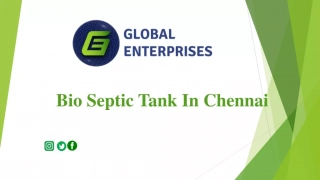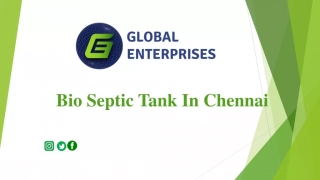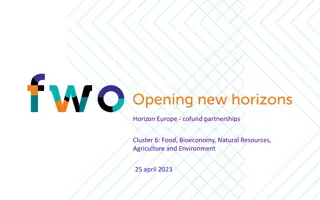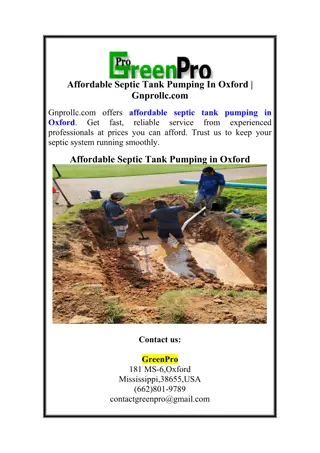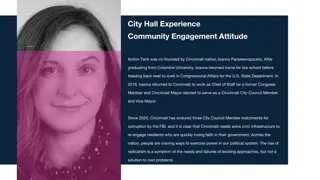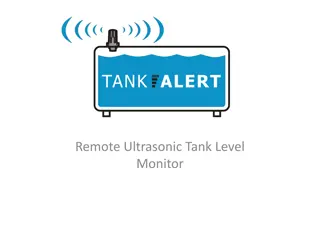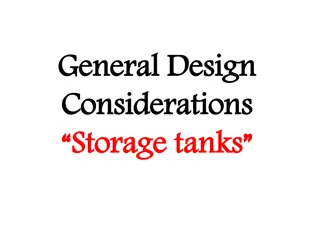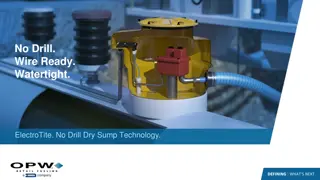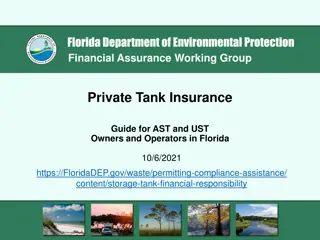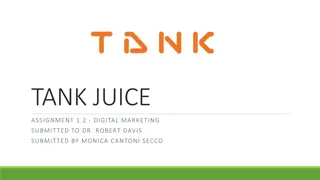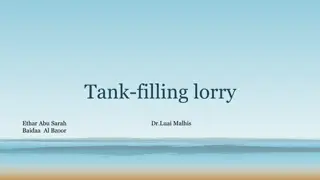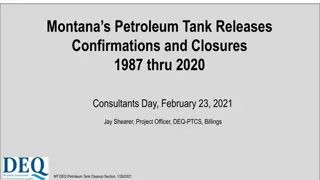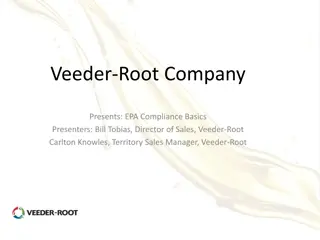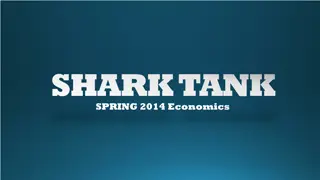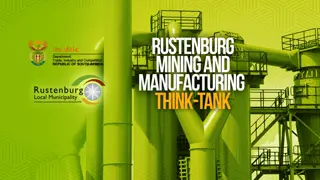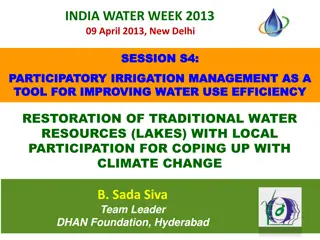Building Strategic Partnerships for Think Tank Impact
This presentation focuses on the importance of partnerships for enhancing think tank impact. It delves into how to identify, engage, and manage partnerships effectively, overcoming challenges such as funding and credibility, and developing practical partnership plans for future implementation. The session breakdown includes understanding, identifying, and structuring partnerships, overcoming challenges, and sustaining partnerships. The starter question prompts reflection on strategic partnerships, while Part 1 explores the role and benefits of partnerships in think tanks, emphasizing collaboration with various stakeholders in the policy ecosystem.
Download Presentation

Please find below an Image/Link to download the presentation.
The content on the website is provided AS IS for your information and personal use only. It may not be sold, licensed, or shared on other websites without obtaining consent from the author.If you encounter any issues during the download, it is possible that the publisher has removed the file from their server.
You are allowed to download the files provided on this website for personal or commercial use, subject to the condition that they are used lawfully. All files are the property of their respective owners.
The content on the website is provided AS IS for your information and personal use only. It may not be sold, licensed, or shared on other websites without obtaining consent from the author.
E N D
Presentation Transcript
Building Strategic Partnerships for Change and Think Tank Impact Lilia Rizk Policy Center for the New South
Main Workshop Objectives: 1) Understand the value and role of partnerships in enhancing think tank impact 2) Learn how to identify, engage, and manage partnerships effectively 3) Overcome Challenges related to funding, credibility, and strategic alignment 4) Develop a practical partnership plan for future implementation
Session Breakdown Part 1: Understanding the Role of Partnerships in Think Tanks Part 2: Identifying and Approaching Potential Partners Part 3: Designing and Structuring Partnerships Part 4: Overcoming Challenges in Think Tank Partnerships Part 5: Sustaining and Scaling Partnerships
Starter Question What comes to mind when you think of a strategic partnership, or one word you would associate with strategic partnership ?
Part 1: Understanding the Role of Partnerships in Think Tanks
Part 1: Objectives This first session will explore: Why partnerships are essential for think tanks Who the key stakeholders are How successful collaborations work in practice Goal: Gain a deeper understanding of the strategic benefits of partnerships and map your own think tank s ecosystem of existing and potential collaborators
If you want to go fast, you should go alone, but if you want to go far, you should go with others .
Part 1: Why Partnerships Matter for Think Tanks 1) Think tanks do not usually operate in isolation 2) Think tanks exist at the intersection of various actors in the policy ecosystem, including the private sector, media, NGOS, academia, and government institutions. 3) Think tanks thrive on collaboration because their core mission producing research to inform politices and solve complex problems requires diverse inputs and a wide reach. Being at the crossroads of these sectors offers unique opportunities for partnerships that enrich their work in several ways. 4) Think tanks often work with others to create space that will be welcoming of other actors in the policy space.
Part 1: Strategic vs. Transactional Partnerships Feature Transactional Partnership Strategic Partnership Duration Short-term, one-time Long-term, ongoing Objective Specific task or service Shared strategic goals Commitment Level Low High Integration Limited Deep collaboration Example Research funding from a company Joint research & advocacy project
Part 1: Why Partnerships Matter for Think Tanks Question to you: Why do partnerships matter in Think Tanks?
Part 1: Why Partnerships Matter for Think Tanks Interdisciplinary Knowledge Exchange Bridge the Research-Policy Gap Enhance Research Quality Enhance Credibility and Neutrality Increase Visibility Expand Policy Influence and Impact Secure funding & leverage resources Drive Innovation
Part 1: Mapping Key Stakeholders in the Policy Ecosystem (Who are they Key Players?) STAKEHOLDER HOW THEY CONTRIBUTE POTENTIAL CHALLENGES Provide policy influence, funding, access to decision- makers Risk of politicization, influence over research agenda, dependency on government funding Government Institutions Offers financial support, industry expertise, and real- world data Private Sector Potential conflicts of interest, Risk of Perceived Bias May push specific advocacy goals that conflict with think tank neutrality may prioritize activism over research rigor Bring grassroots perspectives and implementation capacity NGOs & Civil Society Media Organizations Amplify research findings and shape public discourse Risk of misinterpretation, selective reporting Strengthen research credibility and provide methodological rigor May be too theoretical or slow-moving for policy impact Academic Institutions Expanding expertise and Research Capacity, Strengthening Policy Influence, Enhancing Regional and Global Reach, Knowledge and Best Practice Exchange Differing agendas & priorities, maintaining independence, coordination & logistics. Think Tanks
Part 1: Examples of Strategic and Successful Think Tank Partnerships 1) A Think Tank collaborating with a government ministry to shape economic reform - Example: The Peterson Institute for International Economics partnered with the US Treasury to analyze tax reform, and research findings directly influenced the structuring of new tax legislation. - Key Lesson: Managing Transparency is crucial to preserving credibility while collaborating with policymaker 2) - Partnering with a multinational company for research funding while maintaining independence Example: TheBrookings Institution collaborated with Google ona The partnership secured funding but was structured Google. Key Lesson : Clear boundaries between funders and research report about AI governance. to ensure no editorial interference from - outcomes protect credibility. 3) A media collaboration translates policy research into accessible content - Example: the Chatham House Africa Program partnered with BBC Africa to communicate policy research on climate change. Research findings reached a wider audience, shaping the public debate. - Key Lesson: Working with media requires message control to avoid misrepresentation
Part 1: Activity Stakeholder Mapping Tool In this activity, you will list the key stakeholders your think tank interacts with and discuss gaps in your current partnerships. Step 1: Identify key stakeholders List 5 to 7 key stakeholders your think tank currently engages with or perhaps would like to engage with. Step 2: Stakeholder Mapping Grid Plot stakeholders on the following matrix based on their level of influence and interest in your work, and identify where you need to strengthen relationships. Also try to think if these relationships are more transactional or strategic. Step 3: Choose 2 stakeholders and fill in the table for your think tank
Part 1: Activity Stakeholder Mapping Tool Step 2: Stakeholder Mapping Grid Plot stakeholders on the following matrix based on their level of influence and interest in your work, and identify where you need to strengthen relationships. Also try to think if these relationships are more transactional or strategic. High Influence / High Interest High Influence / Low Interest Potential advocates, senior government officials Strategic partners, funders, policymakers Low Influence / High Interest Low Influence / Low Interest Grassroots organizations, students, small NGOs Peripheral stakeholders with minimal impact Exercise: Plot your key stakeholders on the grid above and identify where you need to strengthen relationships.
Part 1: Activity Stakeholder Mapping Tool Step 3: Choose 2 stakeholders you would like to engage with and fill in the table for your think tank. Stakeholder Potential Benefits Possible Risks Engagement Strategy Government Ministry Access to policymakers, funding Political influence risk Formal MoUs, transparency policies Clear governance, independent research review Private Corporation Financial support, real-world data Perceived bias Media Outlet Wider visibility, public engagement Risk of misrepresentation Pre-agreed messaging, media training
Part 2: Identifying and Approaching Potential Partners
Part 2: Objectives This second part will explore: Structured approach to identify, evaluate and engage potential partners Goal: Better understand how to select the right partners, develop a compelling value proposition, and initiate meaningful collaboration discussions.
Part 2: Identifying and Approaching Potential Partners Question to you: What are the main criteria in selecting strategic partners?
Part 2: Criteria for selecting strategic partners Selecting strategic partners is curcial for long-term success. A strong partnership should be based on mutual alignment, credibilty, and value creation. 1) Alignment of mission and values: ensure that both oganizations share commong goals and ethical standards 2) Complementary expertise and resources: look for partners who bring skills, networks, or funding that your think tank lacks 3) Credibility and reputation: Evaluate the track record, influence and public perception of potential partners 4) Long term commitment vs short term engagement: Define the duration and depth of the partnership early on
Part 2: Activity Creating a Think Tank Partnership Selection Checklist Goal: Develop a tailored checklist to assess potential partners based on their think tank s priorities, mission and operational needs. Step 1: Identify your core partnerhip Criteria Reflect on your think tank s goals and challenges and answer the following: 1) What are the top three objectives you seein in a partnership? (funding? Policy influence? Research collaboration?) 2) What values or ethical considerations are non-negotiable for you? 3) Think about partnership challenges you have faced in the past. What lessons can inform your criteria? Step 2: Based on your answers, create a 5 to 10 point checklist to evaluate potential partners Ex: Strategic Alignment (does this partner share our vision for evidence- based policymaking?), Research & Expertise Fit (does this partner bring knowledge or date that strengthens our work?)
Part 2: Building a Value Proposition for Partnerships What is a value proposition?: Clear and compelling statement that explains why a partnerhsip is beneficial to both parties. It answers the question: What is in it for them. For a think tank, a strong value proposition helps attract the right partners by showing them how the collaboration aligns with their goals, interests and needs. A strong value proposition should highlight: 1) What the think tank offers (ex: research expertise, policity insights, credibility, network access ) 2) What the potential partner seeks (ex: visibility, thought leadership, data access, policy influence ) 3) How the collaboration creates mutual benefits A strong value proposition is about showing why the partnership makes sense and what unique value your think tank brings to the table. Focus on shared benefits, clear impact, and long-term potential.
Part 2: Building a Value Proposition for Partnerships Key elements of a value proposition: 1) The problem or need: Clearly define the challenge or issue in the policy space that requires collaboration 1) Example: Misinformation in climate policy is hindering decision making 2) Your think tank s unique contribution: What expertise, resources, or influence do you bring? 1) Example: our think tank specializes in evidence-based climate policy research and has a strong media presence 3) What s in it for the Partner? How does the collaboration align with their goals? 1) Example: By partnering with us, your organization can access high-quality research and policy insights that strenthen your advocacy efforts 4) The Expected Impact: What is the outcome of the Partnerhsip? 1) Example: Together, we can develop a media campaing that combats misinformation and informs policymakers.
Part 2: Building a Value Proposition for Partnerships Steps to Conduct a Value Proposition: 1) Research your potential partner 1) Understand their mission, priorities, and challenges 2) Identify their previous collaborations and key decision-makers 3) Look at their funding prorities and public statements Understand the partner s motivations and priorities 1) Government agencies: seek policy insights, implementation frameworks 2) Corporations: value brand positions, Environment, social, governance credibilty 3) NGOs & Civil Society: Require date dor advocacy, grassroots influence 4) Media: Need expert analysis, compelling narratives Identify mutual interests 1) Map out where your objectives align 2) Think about how your expertise complements theirs 3) Identify shared challenges you can solve together 4) Ex: a media outlet seeks credible policy analysis, while your think tank wants to amplify its research. A partnership could involve co-publishing reports or op-ed. Frame the Pitch and craft a tailored message 2) 3) 4)
"Our think tanks latest research on digital economy regulations aligns with your company s interest in responsible AI development. By collaborating, we can produce a policy white paper that informs decision-makers while highlighting your commitment to ethical AI governance."
Part 2: Value Proposition example for NGOs & Civil Society Organizations Dear [NGO Representative], Effective advocacy requires strong research, compelling narratives, and strategic partnerships. At [Think Tank Name], we focus on [Policy Area], ensuring that policy recommendations are backed by credible research and real-world impact. We admire [NGO Name] s dedication to [Cause] and believe that by joining forces, we can: -Combine research and advocacy to drive policy change. -Create joint reports and policy briefs that amplify both our missions. -Organize public forums and stakeholder dialogues to influence decision-makers. By leveraging our research expertise and your grassroots experience, we can create a stronger case for policy reforms that benefit [Target Group]. Let s connect and discuss how we can align our efforts for greater impact. Would next week work for a quick conversation? -
Part 2: Value Proposition example for NGOs & Civil Society Organizations As businesses navigate [Industry Challenge], access to high-quality policy research and data-driven insights is essential. [Think Tank Name] specializes in [Relevant Research Area], providing actionable recommendations that align with corporate strategies and regulatory trends. We see a strong alignment between your company s commitment to [Corporate Goal] and our expertise in [Research Area]. By collaborating, we can: -Conduct joint research that informs both corporate strategy and policy discussions. -Organize high-impact events, bringing together industry leaders and policymakers. -Provide insights that enhance your company s thought leadership in [Industry]. This partnership offers an opportunity to not only advance industry-wide discussions but also position [Company Name] as a leader in shaping the future of [Industry or Policy Area]. I d love to schedule a call to explore how we can create mutual value through this collaboration. Would you be available next week?
Part 2:Outreach Strategies: Building Trust and Initiating Conversations 1) Warm introductions vs. Cold outreach 1) Warm introductions: Leverage existing networks, ask mutual contacts to make introductions 2) Cold Outreach: if no direct connection exists, personalize communication and refernece shared interest 2) Hosting joint events, conferences, roundtables, or policy forums 1) This can serve as a low-commitment first step towards a more lasting and sustainable collaboration/strategic partnership 2) Example: a think tank invites corporate executives to a roundtable on business and public policy, opening doors for future partnerships
Part 2:Activity Value Proposition Instruction: Draft a 3 to 5 sentence partnership pitch for a potential partner. Pair up, and pitch it to your neighbor in 60 seconds. Opening Statement Identify the shared challenge or opportunity Your Think Tank s Unique Contribution Highlight your expertise and value What s in It for Them? Explain why the partnership benefits them Expected Impact Define the outcomes of the collaboration Call to Action Suggest next steps Discussion: What worked, what didn t?
Part 3: Designing and Structuring Partnerships
Part 3: Objectives This third part will look into different partnership models, the selection of the right structure for your think tank s needs, and the establishment of clear roles and expectations. Goal: Equip you to design effective partnerships that enhance your think tank s impact while mitigating risks.
Part 3: Common Think Tank Partnerships Partnership Type Key Benefits Example Enhance research credibility, access to experts, and student engagement A think tank collaborates with a university to publish a joint policy paper on climate change Academic Partnerships Provide funding, real-world data, and sector-specific insights A think tank works with a multinational company to study economic development trends Corporate Partnerships Enable policy influence, direct access to decision- makers Governmental Partnerships A think tank advises a ministry on regulatory reforms Bring engagement grassroots knowledge, expand public A think tank partners with an NGO to co-host a civic engagement workshop Nonprofit/NGO Partnerships Strengthen cross-regional expertise, increase research visibility Two think tanks from different countries co-develop a comparative policy analysis Think Tank-to-Think Tank Collaborations
Part 3: Types of Partnerships Research Collaborations - Purpose: To co-produce knowledge, enhance credibility, and combine expertise for deeper policy insights - What does it look like? - Joint studies, reports, or policy recommendations - Comparative research across regions and sectors - Data sharing agreements institutions share proprietary datasets to enrich anayses - Example: A think tank collaboration with a university to produce a longitudinal study on economic growth and inequality in Latin America
Part 3: Types of Partnerships Funding Partnerships - Purpose: To secure financial support for research, events, or institutional sustainability while maintaining independence - What does it look like? - Grants from foundations and international donors for multi-year research projects - Corporate sponsorship private sector entities fund policy initiative aligned with their industries - Example: A multinational company sponsors a research project on sustainable energy policy, with clear ethical funding guidelines
Part 3: Types of Partnerships Advocacy and Outreach Partnerships - Purpose: To increase public engagement and make policy research more accessible to broader audiences. - What does it look like? - Joint awareness campaings collaborating with NGOs or media outlets to influence public opinion - Co-host policy dialogues and debates, brining together policy makers, business leaders, and academics - Example: A think tank partners with a journalism network to create a podcast series translating research findings into public- friendly narrative.
Part 3: Types of Partnerships Knowledge Exchange - Purpose: To foster dialogue between experts and decision-makers for better policy solutions - What does it look like? - Conferences and roundtables Multi-stakeholder discussions on pressing policy challenges - Secondments and researcher exchanges Temporary placement of think tank staff in government, academia, or international institutions - Example: A policy analyst from a North African Think Tank spends six monts at a central bank to provide insights on financial inclusion.
Part 3: Types of Partnerships Capacity Building - Purpose: To strenthen the institutional, research, and operational capacities of think tanks and partners. This involves investing in human resources, institutional processes and knowledge sharing mechanisms to improve the effectiveness of think tanks. What does it look like? - Training and skill development workshops on policy research, data analysis, strategic partnerships and communications - Institutional development programs Support for governance, strategic planning and operational efficiency - Peer mentoring and advisory support More experienced think tanks guide emerging organizations Example: A leading think tank in South Africa partners with a newly established policy institute in Zambia, providing technical training and mentorship on policy analysis methods. Over time, the Zambian think tank develops stronger internal research capabilities, allowing it to contribute more actively to national debates. - -
Partnerships can be multidimensional, multistakeholder, and multipurpose.
Part 3: Formal vs. Informal Partnerships Factor Formal Partnership Informal Partnership Structure Legally documented (e.g., MOUs, contracts) Verbal agreement, handshake deal Commitment Medium to long-term Short-term or flexible Risk Level Clearly defined roles and responsibilities, lower risk Potential for misunderstandings, higher risk A think tank and a journalist informally exchanging insights Example A corporate-funded research study with clear terms
Part 3: Legal and Contractual Considerations 1) Memorandum of Understanding (MOU): Define roles but are non-binding 2) Contracts: Specify deliverables, funding, ownership rights 3) Intellectual Property Rights (IP): Clarify who owns the research 4) Confidentiality Agreements: Protect sensitive information 5) Risk Management: Ensure ehtical funding sources, compliance with regulations
Part 3: Defining Roles and Expectations 1) Setting clear objectives and deliverables 1) What are the expected outputs (joint publication? a conference? ) 2) What are the key performance indicators to measure success? 2) Managing workloads and responsibilities 1) Who will take the lead on different tasks? 2) How will resources be allocated and shared? 3) Maintaing transparency in funding and decision-making 1) What are the funding terms and conditions? 2) How will joint decisions be made?
Part 3: Activity Partnership Puzzle Partnerships in think tanks require several interconnected elements to be effective Instruction: 1) Break into 5 groups 1) Group 1: Think tank and Media Organization 2) Group 2: Think tank and NGO 3) Group 3: Think tank and Government 4) Group 4: Think tank and Corporation 5) Group 5: Think tank to think tank 2) Assemble the ideal partnership by prioritizing and arranging these components in a way that makes sense:
Part 3: Activity Partnership Puzzle Resources & Contributions: Financial, intellectural, human or technical contributions from each partner Communication & Coordination: How partners will stay in touch, share updates, and manage collaboration Exit strategy: When and how the partnership should conclude or evolve Legal & Compliance Framework: Required agreements, regulatory considerations, and governance structure Power Dynamics & Influence How decision-making authority is shared, especially between asymmetric partners Roles & Responsibilities: Who does what, ensuring clarity and accountability Decision-Making Process: Who makes final calls? How are decisions negotiated? Trust & Reputation Management: How partners ensure credibility and transparency Risk Management & Conflict Resolution: Anticipating potential risks and defining how conflicts will be resolved Impact Measurement & Evaluation: How success is tracked and reported Scalability & Replicability: Can the partnership model be expanded or replicated elsewhere? Shared Goals & Vision: Clearly defined purpose and alignment of objectives
What components were non-negotiable? Which ones varied depending on the type of partnership? What elements are often overlooked but essential?
Part 4: Overcoming Challenges in Think Tank Partnerships
Part 4: Objectives This fourth part will focus on recognizing and addressing the challenges that arise in think tank partnerships while ensuring independence, credibility and long-term sustainability.
Part 4: Common Pitfalls in Partnerships and How to Avoid Them Conflict of Interest: These arise when a think tank s research, recommendation or policy influence could be compromised by its financial or institutional relationship with funders, partners, or affiliated organizations. Different types of conflicts of interest: 1) Financial conflicts of interest 1) A TT receives funding from a corporation, government, or special itnerest group that has a direct stake in the research outcomes 2) Example: A pharmaceutical company funds a think tank s healthcare policy research, potentially influencing findings in favor of industry interests. 3) Solution: Maintain funding transparency, disclose financial relationships, and ensure editorial independence in all research outputs. 2) Intellectual conflicts of interest 1) Researchers or leadership within the think tank have strong personal, ideological, or professional ties to an external organization, affecting objectivity. 2) Example: A TT researcher is also a consultant for a government agency, which could bias recommendations in favor of government policies 3) Solution: Establish clear conflict-of-interest politices requiring disclosure of external affiliations and ensuring independent peer reviews. 3) Agenda setting conflict of interest 1) A funder or partner subtly or explicity shapes the research agenda, prioritizing topics that serve their interests while discouraging critical perspectives. 2) Example: A major tech company funds AI policy research but discourages studies that critique its data privacy practicies. 3) Solution: Ensure diversified funding so that no single entity dominates the think tank s agenda. Maintain independent advisory boards for research oversight.
Part 4: Common Pitfalls and How to Avoid Them Ideological Differences Maintaining credibility when working with politically affiliated entities: - Partnering with governments, political groups or ideologically driven organizations can create perceptions of bias - How to avoid this: - Clearly define the terms of engagement in non-partisan evidence based research - Avoid exclusive partnerships with politically motivated organizations - Stengthen peer review mechanisms to uphold academic and policy rigor


